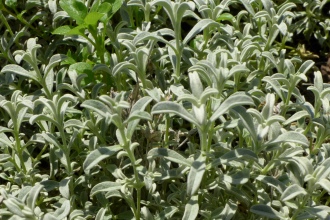Position: Full sun
Flowering period: Late spring to early summer
Soil: Moist, well drained
Eventual Height: 15cm
Eventual Spread: 30cm
Hardiness: 4a, 4b, 5a, 5b, 6a, 6b, 7a, 7b, 8a, 8b, 9a, 9b
Family: Caryophyllaceae
Cerastium candidissimum is an evergreen herbaceous perennial with a mounding habit. Its sliver/ grey/ green leaves are lanceolate with entire margins, up t0 2cm long and 7mm across. Its white flowers are up to 2cm across.
Cerastium candidissimum, commonly known as Silver Carpet or Greek Snow in the summer, is native to the mountains of west and south Greece. In its native habitat it grows in rock scrub lands and sub alpine meadows.
The etymological root of the binomial name Cerastium is derived from the Greek keras meaning ‘a horn’. Candidissimum is derived from the Latin candida meaning ‘bright’ or ‘pure’, in reference to the flower.
The landscape architect may find Cerastium candidissimum useful as a low growing ground cover perennial. Once established this plant is drought tollerant.
Ecologically, Cerastium candidissimum flowers are attractive to pollinating insects.
Cerastium candidissimum prefers moist, fertile, well-drained soils. It tolerates most pH of soil. It will not tolerate wet soils.
Cerastium candidissimum requires little maintenance.
![]()
Landscape Architecture











